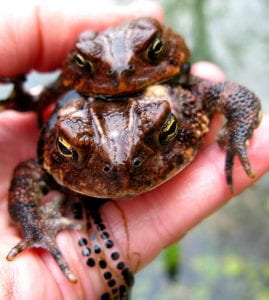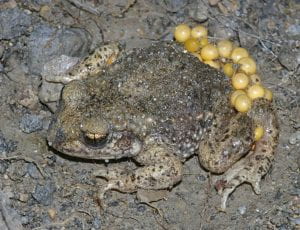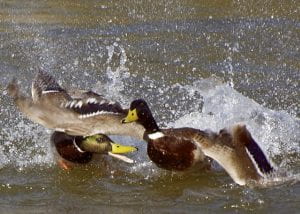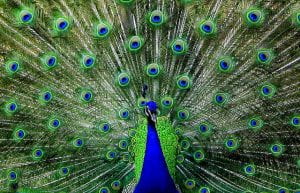Learning Objectives
- Define and differentiate between internal and external fertilization as two ways that egg and sperm unite in sexually reproducing species
- Define biological fitness and parental investment, and use these two concepts to explain why females are more likely than males to be “choosy” about mates (female choice)
- Define sexual selection, give and recognize examples of secondary sexual characteristics, and describe different ways that males compete for mates (male-male competition)
When we consider the question “why sex?”, one answer stems from the evolutionary benefits to intermingling genes with the genes of a chosen mate to maximize the awesomeness of the children and their future children. In evolutionary terms, the children’s awesomeness is entirely based on their survival and ability to reproduce viable, fertile offspring—in other words to provide grandchildren. Biologists have studied the evolutionary strategies that maximize survival and reproduction.
Define and differentiate between internal and external fertilization as two ways that egg and sperm unite in sexually reproducing species
Sexual reproduction starts with the combination of a sperm and an egg in a process called fertilization, which can occur inside (internal fertilization) or outside (external fertilization) the body of the female.
External fertilization (adapted from OpenStax Biology 43.2) requires water to allow sperm and egg to find each other and to protect the developing embryo from drying out, so it is more common in marine and aquatic habitats than on land.
Getting the sperm and egg together requires that the gametes be released at the same time and in the same location to increase the likelihood of fertilization (otherwise all those gametes are wasted!). How does that happen?
- In some fish, crustaceans, mollusks, and other invertebrates, environmental cues (e.g. temperature or day length) or biological pheromones cause males and females to release gametes at the same time. This results in a cloud of gametes and is called broadcast spawning.
- Many amphibian males court individual females to induce them to release eggs. The males then immediately release sperm to fertilize those eggs. Many toads (see image) have external fertilization, even though they are in close physical contact.

During sexual reproduction in toads, the male grasps the female from behind and externally fertilizes the eggs as they are deposited. (credit: “OakleyOriginals”/Flickr)
Internal fertilization (adapted from OpenStax Biology 43.2) is the reproductive mode for most land-based animals, and also occurs in some aquatic animals. After internal fertilization, the fertilized eggs can be:
- laid outside the female’s body and develop there, and the embryo receives nourishment from the yolk that is a part of the egg. This occurs in most bony fish, many reptiles, some cartilaginous fish, most amphibians, two mammals (platypus and echidna), and all birds.
- retained inside the female, but the embryo receives nourishment from the egg’s yolk and the young are fully developed when they are hatched. This occurs in some bony fish, some sharks, some lizards, some snakes, and some invertebrates.
- retained inside the female, and the embryo receives nourishment from the mother’s blood through a placenta. The offspring develops in the female and is born alive. This occurs in most mammals, some cartilaginous fish, and a few reptiles.
Internal fertilization protects the fertilized egg from drying out, protects offspring from predation, and also increases the likelihood of fertilization by a specific male. While fewer offspring are produced through internal fertilization, offspring survival is higher than for external fertilization.
Females are “choosy;” males are not
“Females are choosy, while males are not” is a gross generalization, but biologically it tends to be true across most species that reproduce sexually, whether they reproduce with internal or external fertilization. Read on to explore how biological fitness and parental investment play into this major difference between male and females in many species.
Generally females invest more energy, care, and time in the offspring than a male does, and she has a limited number of eggs compared to practically limitless sperm produced by males of most species. Because of her higher investment, if a female mates with a male of poor genetic quality, and that choice results in no offspring survival, she has wasted energy and resources and ended up with nothing.
Alternatively, a male can mate with practically unlimited numbers of females with little loss of energy or resources, regardless of how successful those offspring may be. In other words, eggs are “expensive” and sperm are “cheap.” Thus, generally a female maximizes her reproductive success by mating with the “best” male she can, while generally a male maximizes his reproductive success by mating with as many females as possible.
Any situation where one gender selects specific individuals to mate with will result in a phenomenon called sexual selection. Sexual selection is a type of natural selection where one sex has a preference for certain characteristics in individuals of the other sex. As with any type of selection, this preference increases the reproductive success of individuals who have the preferred characteristic.
Because females of most sexually reproducing species are “choosy,” females are often the gender that sexually selects traits in males. As a result, males compete with each other for access to females or induce a specific female to mate with them. As a result of this competition, sexual selection often leads to sexual dimorphism, distinct differences in size or appearance between males and females. These differences in size or appearance, called secondary sexual characteristics, are exaggerated or showy traits that are associated with mating behaviors and reproductive success. Examples include breasts, showy tails and headpieces, and crazier traits like the length of the eye-stalks in stalk-eyed flies (see image below).

Stalk-eyed flies have eyes at the end of long stalks, and they compete for mates by measuring the distance between their eyes. Evidence shows that wider eye placement wins in these bouts of male competition. (Image credit: Jojo Cruzado – stalk eyed fly, CC BY 2.0, https://commons.wikimedia.org/w/index.php?curid=39304119)
Sexual dimorphism can lead to specific behaviors in males that increase their reproductive success. Significant energy is spent in the process of locating, attracting, and mating with the sex partner.
Competition among males occurs whether species mate via internal or external fertilization. In species with internal fertilization, only one male can mate with a female at a time, so males compete with each other for mating with a particular female. In species with external fertilization, the female controls how and when the eggs are released, and males compete for access to her eggs outside of her body.
Adaptations increase reproductive success
Recall from learning about evolution by natural selection that adaptations, the traits that increase an individual’s reproductive success, occur without conscious thought or intention on the part of the individual. Selection results in the evolution of different strategies for maximizing biological fitness, or reproductive success relative to others in the population. An individual who has, for example, 10 surviving offspring (who then go on to reproduce as well) has higher fitness than an individual who has 7 surviving offspring.
Some of the adaptations around sexual reproduction include parental investment, direct male competition, and indirect male competition:
Parental investment is any energy, effort, or resource that a parent provides to increase the offspring’s chances of survival, but at the cost of the parent’s ability to invest in other offspring. The benefit paired with cost is an example of an evolutionary trade-off. Parental investment can include parental care, energy resources deposited in the egg, and nutrition provided to the developing embryo. Parental investment can occurs both in species with internal or external fertilization. Some examples are shown in the images below:

The male of the common midwife toad, Alytes obstetricans, carries the fertilized eggs on his hind legs until they are ready to hatch. By Christian Fischer, CC BY-SA 3.0, https://commons.wikimedia.org/w/index.php?curid=7344145
Males often engage in direct male competition over potential mating partners. This type of competition occurs when females mate only with a single male, typically the “winner” of the competition. Direct male competition often includes aggression (fighting) between males, but there are other forms as well:

Male-male aggression in Mallard ducks. Image credit:
Ken Clifton/Flickr
- Male-male aggression: males fight with each other for access to females
- Courtship rituals:males engage in “dances” or other displays to attract females
- Lekking: a specialized form of courtship ritual where many males gather together in one place and “display” at the same time, allowing females to easily choose among them

The peacock’s tail is used on courtship displays to attract females. Females prefer males with larger, more colorful tails. Image credit:
Özgür Mülazımoğlu/Flickr
Competition between males is half of the story: females choose which males to mate with based on observing the male competition. Selection of the “best” male by females is called female choice. Female choice and direct male competition usually lead to selection for extremely “showy” traits that do not appear to provide any benefit to the individual’s survival, and might even make it more likely for the animal to be eaten by a predator (think of the peacock’s tail – see image). But if the trait improves the male’s ability to produce successful offspring because more females choose to mate with him, then these traits do in fact improve an individual’s biological fitness, even at the cost of decreasing its survival!
One question is why females should “care” about these showy male traits. A leading hypothesis to answer this question is the good genes hypothesis, which is the idea that these sexually-selected, showy male traits are “honest indicators” of good genetic quality. In other words, it takes good genes to make a big flashy tail (and to avoid being eaten by a predator, since that big tail slows him down), so the bigger and showier the tail, the “better” the male.
This video gives a brief overview of the implications of the good genes hypothesis and sexual selection in humans:
Instead of (or in addition to) competing directly with each other to have the opportunity to mate with a female, males can also compete for fertilization of a female’s eggs after mating has already occurred! Competing after mating is also called indirect male competition, or sperm competition, and it results in one male being more successful than another at fertilizing a female’s eggs. This type of competition occurs in species where the female is likely to mate with multiple males, so instead of males directly competing with each other, they are competing via their sperm. In other words, if a female mates with more than one male, then any male whose sperm end up fertilizing more eggs is going to have more offspring, on average, than other males. So if there is a trait that makes this male’s sperm more successful than other male’s sperm, then that trait is going to end up increasing in the population over generations.

The genitalia of the male Callosobruchus analis beetle is covered in spines from base to tip; the spines facilitate removal of sperm deposited in the female’s reproductive tract by previous males. Referenced in Rönn, J., Katvala, M. & Arnqvist, G. 2007. Coevolution between harmful male genitalia and female resistance in seed beetles. Proceedings of the National Academy of Sciences 104, 10921-1092. and Hotzy, C. & Arnqvist, G. 2009. Sperm competition favors harmful males in seed beetles. Current Biology 19, 404-407.
Traits that increase success during sperm competition include:
- Mate guarding: a male remains close by the female after mating, preventing other males from mating with her until there has been time for his sperm to fertilize the eggs
- Copulatory plugs:the male’s ejaculate includes a sticky residue which temporarily blocks entry to the female’s reproductive tract, making it difficult for other males to mate with her until after there has been time for the first male’s sperm to fertilize the eggs
- Elaborate penis morphology:elaborate structures on the penis help remove the sperm of previous males from the female’s reproductive tract by essentially scraping out the previous ejaculate
- Large ejaculate volume and large testes:a large volume of ejaculate helps to flush out the sperm deposited in the female’s reproductive tract by the previous male; a large ejaculate volume means the testes must also be large, in order to have enough space to hold all the sperm
Female anatomy can also influence the success of sperm from specific males in a process called cryptic female choice, where a female is capable of preferentially using sperm from a specific male, even if she has mated with multiple males. This process is poorly understood but suggests that male-male competition alone does not dictate success of a male’s sperm in fertilizing an egg.
This video provides a great overview of sperm competition, but be aware that it erroneously refers to bonobos as having a polygynous or polygamous mating system (they are promiscuous) and gorillas as being monogamous (they are polygamous).
